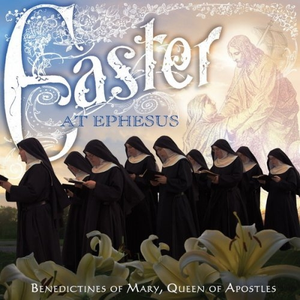He presented his work to Conrad's son, Henry III, in 1046, not long after Henry was crowned. In this Wipo fully understands his subject, is fresh and animated, and, although affectionate, is not a mere eulogist or a flatterer, for he sees Conrad's failings clearly. But he does not fully grasp the general conditions of the age, especially the emperor's manifold relations to the ruling princes and the Church. His style is simple and fluent, and his language well-chosen.
Among his other extant writings are the maxims, Proverbia (1027 or 1028), and Tetralogus Heinrici in rhymed hexameters. Presented to Emperor Henry in 1041, it is a eulogy of the emperor mixed with earnest exhortations, emphasizing that right and law are the real foundations of the throne. He wrote a touching lament in Latin on Conrad's death, and is believed to have written the famous sequence for Easter, Victimae paschali laudes (though the attribution of this chant to Wipo is uncertain
Victimae Paschali
Wipo of Burgundy Lyrics
Jump to: Overall Meaning ↴ Line by Line Meaning ↴
Immolent Christiani.
Agnus redemit oves:
Christus innocens Patri
Reconciliavit peccatores.
Mors et vita duello
Conflixere mirando:
Dux vitae mortuus,
Dic nobis Maria,
Quid vidisti in via?
Sepulcrum Christi viventis,
Et gloriam vidi resurgentis:
Angelicos testes,
Sudarium, et vestes.
Surrexit Christus spes mea:
Praecedet suos in Galilaeam.
Scimus Christum surrexisse
A mortuis vere:
Tu nobis, victor Rex, miserere.
Amen. Alleluia.
The lyrics to Wipo of Burgundy's song Victimae Paschali are centered around the Christian belief of the resurrection of Jesus Christ. The opening line "Victimae paschali laudes" can be translated to "Let us sing the praises of the paschal victim" and refers to Jesus Christ who is the Paschal sacrifice. The second line "Immolent Christiani" means "Let Christians offer a sacrifice" and represents the idea that Christians should offer their own lives to God in the same way that Christ offered his life for them.
The third line "Agnus redemit oves" can be translated to "The Lamb has redeemed the sheep" which depicts Jesus Christ as the Lamb of God who sacrificed himself for the salvation of humanity. The fourth and fifth line "Christus innocens Patri / Reconciliavit peccatores" means "Christ, innocent to the Father, reconciled sinners" and highlights the belief that Jesus Christ reconciled humanity to God through his death and resurrection.
The following two lines "Mors et vita duello / Conflixere mirando" portray the conflict between death and life in the resurrection of Jesus Christ. The next line "Dux vitae mortuus, Regnat vivus" can be translated to "The leader of life, though dead, reigns" and represents the belief that despite his death, Jesus Christ continues to reign over the living.
The second stanza of the song is a dialogue between the Virgin Mary and the Angel, where Mary is seen as a witness to the resurrection. The lines "Dic nobis Maria, Quin vidisti in via?" means "Tell us, Mary, what did you see on the way?" and Mary responds with "Sepulcrum Christi viventis, Et gloriam vidi resurgentis" meaning "I saw the tomb of the living Christ, and the glory of the risen one." The dialogue then continues with Mary describing the evidence of the resurrection, including the linen cloth and clothing left in the tomb.
Overall, Victimae Paschali is a powerful depiction of the passion and resurrection of Jesus Christ and highlights the Christian belief in the reconciliation of humanity with God through his sacrifice.
Line by Line Meaning
Victimae paschali laudes
Let us offer praise to the Paschal victim
Immolent Christiani.
All Christians should sacrifice
Agnus redemit oves:
The lamb has redeemed the sheep
Christus innocens Patri
Christ, innocent before the Father,
Reconciliavit peccatores.
Reconciled sinners to the Father.
Mors et vita duello
Death and life have contended
Conflixere mirando:
In a singular battle;
Dux vitae mortuus,
The Prince of life, who died,
Regnat vivus.
Now lives and reigns.
Dic nobis Maria,
Tell us, Mary,
Quid vidisti in via?
What did you see on the way?
Sepulcrum Christi viventis,
The tomb of Christ, who is alive,
Et gloriam vidi resurgentis:
And I saw the glory of the Resurrection:
Angelicos testes,
The angels testified,
Sudarium, et vestes.
Shroud and clothes lying.
Surrexit Christus spes mea:
Christ, my hope, has risen:
Praecedet suos in Galilaeam.
He will go before his own to Galilee.
Scimus Christum surrexisse
We know that Christ has truly risen
A mortuis vere:
From the dead: truly
Tu nobis, victor Rex, miserere.
O Christ, our victorious King, have mercy on us!
Amen. Alleluia.
Amen. Alleluia.
Contributed by Riley O. Suggest a correction in the comments below.

@GeishaOperaSinger
Oh my god✨You sing so beautifully ✨
You are so talented 🎶🐦🎶
@VernonSnyderKeyboard
Coming from such a lovely singer like yourself, that means a lot to me, thank you!